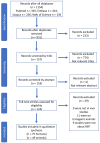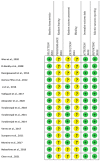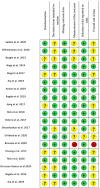Tissue Characteristics in Endodontic Regeneration: A Systematic Review
- PMID: 36142446
- PMCID: PMC9504778
- DOI: 10.3390/ijms231810534
Tissue Characteristics in Endodontic Regeneration: A Systematic Review
Abstract
The regenerative endodontic procedure (REP) represents a treatment option for immature necrotic teeth with a periapical lesion. Currently, this therapy has a wide field of pre-clinical and clinical applications, but no standardization exists regarding successful criteria. Thus, by analysis of animal and human studies, the aim of this systematic review was to highlight the main characteristics of the tissue generated by REP. A customized search of PubMed, EMBASE, Scopus, and Web of Science databases from January 2000 to January 2022 was conducted. Seventy-five human and forty-nine animal studies were selected. In humans, the evaluation criteria were clinical 2D and 3D radiographic examinations. Most of the studies identified a successful REP with an asymptomatic tooth, apical lesion healing, and increased root thickness and length. In animals, histological and radiological criteria were considered. Newly formed tissues in the canals were fibrous, cementum, or bone-like tissues along the dentine walls depending on the area of the root. REP assured tooth development and viability. However, further studies are needed to identify procedures to successfully reproduce the physiological structure and function of the dentin-pulp complex.
Keywords: animal model; dentin-pulp complex regeneration; pulp injury; pulp necrosis; regenerative endodontics.
Conflict of interest statement
The authors declare no conflict of interest.
Figures










References
-
- American Association of Endodontists Endodontic Diagnosis. 2013. [(accessed on 28 July 2022)]. Available online: https://www.aae.org/specialty/newsletter/endodontic-diagnosis/
-
- Duggal M., Tong H.J., Al-Ansary M., Twati W., Day P.F., Nazzal H. Interventions for the endodontic management of non-vital traumatised immature permanent anterior teeth in children and adolescents: A systematic review of the evidence and guidelines of the European Academy of Paediatric Dentistry. Eur. Arch. Paediatr. Dent. 2017;18:139–151. doi: 10.1007/s40368-017-0289-5. - DOI - PMC - PubMed
Publication types
MeSH terms
LinkOut - more resources
Full Text Sources

